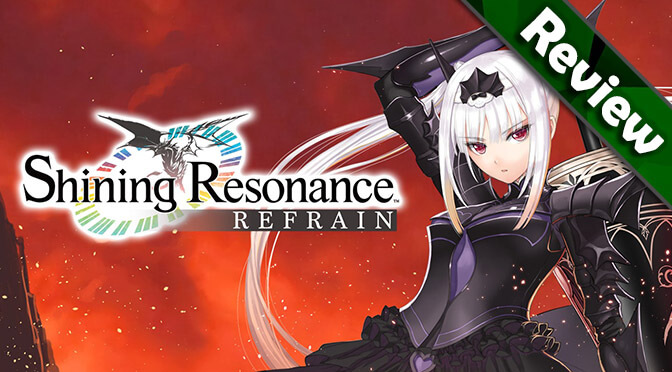Shining Resonance Refrain is a Media.Vision-developed (Wild Arms series) SEGA-published action-JRPG originally released exclusively in Japan in 2014 for the PlayStation 3. All these years later the Western world gets to experience this lively but dated blend of visual-novel storytelling, dating simulation, third-person adventuring, and party-based real-time combat.
Before going further, let’s be very clear: Refrain, in essence, is a long stage-play presented as a video game. The actual playing of the game, from the unexciting exploration and combat to the simple quests, is just an excuse to lead to the next lengthy dialogue exchange as two characters pop up on whatever backdrop is at hand.
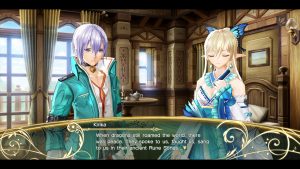
To put it another way, other games show you, but Refrain is all about telling you! For example, games like Skyrim or Dark Souls take you on epic geographical journeys. They want you to feel like you’ve truly hiked the snowy Nordic mountains or delved deep into an ancient city. Not in this game though!
Rather, Refrain is all about the human connection. It’s the people that matter; the setting is mostly irrelevant. The goal is to have you truly feel like you’ve delved deep into the hearts of these characters as you go on an epic interpersonal journey.
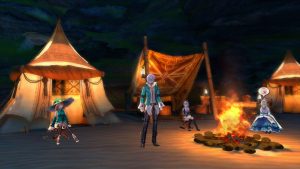
And so, before discussing the more typical video game review elements, I feel compelled to get personal with you. I must share how my 60+ hours has affected my heart, for if I haven’t been moved as the reviewer, then you might as well stop now and move on to a technically superior and better designed game. But wait! Refrain might be worth your time! Let me tell you why.
“To push ahead no matter what people say, no matter the consequences…that is what true strength means…” – Georg
Have you ever felt alone? I know I have. There have been periods in my life when I’ve had to endure abuse and despair. It’s tough to find a real friend, especially when you’re hurting and at your lowest. Yet even in the midst of darkness, a friend can come along and rekindle your soul. And what joy if you can do the same for another!
Well, Yuma, the main character, begins in a dark place. He’s weak and ineffectual, not even sure why he should bother if nobody cares. Then friendship finds him. As the story unfolds he learns there can be purpose to life, much like I found purpose as a young person because someone made me feel valued as a human being.
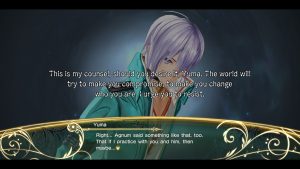
This is the true power of Shining Resonance Refrain, the power of the bonds you form between Yuma and his friends. You’re the bearer of the Shining Dragon (you’ve got a dragon inside you), and as you grow closer to your friends you can resonate (connect) more powerfully.
There’s gameplay mechanics to this resonance, but what really matters is the bond the player forms in their heart with their friends.
With that in mind, let me tell you about my new friends. Agnum is vibrant, coming across as carefree and bold, but he’s actually still learning how to live this thing called life. Lestin is so capable and deadly serious, but if you keep at him he’ll eventually open up.
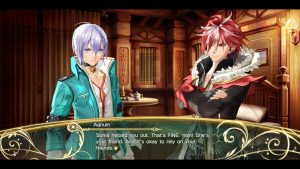
Sonia is the king’s daughter and is glad to inspire her people, but she struggles with comparing herself to others as she thinks she’s falling behind in life. Rinna, well, she’s just crazy! Just kidding! You’ll have to find out for yourself her deep, dark secrets!
“What!? Are you insane!? I am not wearing
women’s clothes into a dungeon!” – Lestin
These characters (and the rest) are my friends because they care for me. We’re committed to each other, and they support me both on the battlefield and in times of rest from the ongoing war. I’ve spent countless hours chatting and being silly with them.
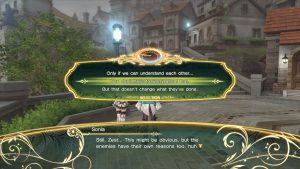
And so, what compelled me to play 60+ hours was not the passable graphics, clunky combat, or weak exploration. No, I endured all that because of my friends. I played on because I wanted to be there for Sonia, for her people, for everyone.
As the story played out I even began feeling for the supposed villains, glad to see their complexities and struggles revealed. Yes, this game is very human, and will move your heart if you let it.
“A person so burdened with guilt might be
a traitor in deed, but not in heart.” – Excella
On a less positive note, just like real friends, sometimes it takes a while to find common ground. In Refrain’s case, despite eventually becoming very strong, the story takes far too long to get going.
At the start the game seems like fairly generic anime-fantasy fluff, and you’d be forgiven for writing it off as another poorly-written JRPG that relies on over-sexualized girls instead of solid gameplay.
For instance, in the prologue poor Yuma just wants to stay in prison, getting tortured from time to time…but his inner-dragon reminds him that girls need him! And lo, the first impression wasn’t good!
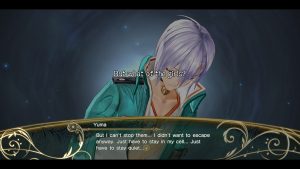
On the topic of girls, it must be said that the lead character designer is a guy known for his extensive age 18+ Japanese cartoon (manga) art. Hence, the game definitely features scantily-clad chest-heavy females in provocative poses with alluring anime-eyes and girlish giggling galore, tee hee!
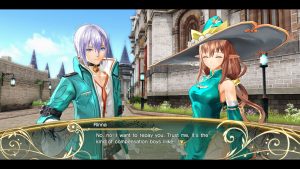
Frankly, the more sexualized female character designs are simply not needed. The characters are complex and interesting as they are, and it feels like the character designer is feeding his own agenda rather than designing characters true to their personalities. But whatever. At least the character outfits are colorful and beautiful!
The Gameplay Reviewed
Enough talk! Let’s finally get to the actual playing! In short, the gameplay isn’t good. It’s tedious, often ugly, fairly messy, and far too unbalanced. It’s hard to know where to begin given all the issues…
“Even a sad, violent, scarred world like
this one deserves to be saved.” – Jinas
For starters, the game only has one basic gameplay loop. You have your long dialogue scenes setting your next objective. Then you get placed into the city, and venture out the main gates. You tromp through a few zones to maybe a forest or desert where something triggers another dialogue scene and possibly a boss fight.
Now you inevitably make your way back to the city for the next long dialogue segment. The cycle repeats, but next time you venture out a few zones further. By the end of the game you’ll have traversed some of these zones a good forty times. Yeah for trotting tedium!
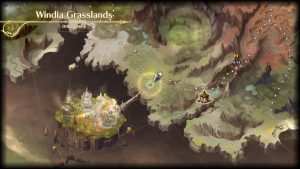
What makes the constant back and forth even worse is how totally uninspired the actual environments are both visually and design-wise. Each zone is just a large path with a couple offshoots. This isn’t realistic or creative or interesting, and this is why the game is more like a stage-play where the locations feel like painted backdrops.
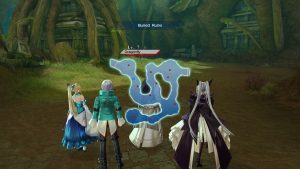
Graphically, Refrain’s PS3 origins are clearly evidenced by the quite low-polygon and sparse environments. It’s unfortunate that the game didn’t receive a modern graphical upgrade since they’re charging close to full price for the game.
Also note, Refrain doesn’t feature any form of auto-saving. Forcing manual saving at archaic save points with no auto-saving is unforgivable in 2018. That is all I have to say about that.

Then there’s the combat system. Oh boy. This isn’t going to be good. So clunky! So imprecise! So…slow! The basic idea is you see an enemy in the world, engage it, more enemies appear, and battle ensues. You’ve got regular combo attacks and break attacks to “break” the enemy’s defenses, along with a vast number of skills (called Forces) like magic, healing, buffs, and debuffs.
That sounds reasonable, but already we have huge problems. The game wants you to “break” enemies…except the “broken” window is senselessly brief, usually a couple seconds. If we do some simple math, it is often superior to simply spam regular combo attacks.
“He’s a knight of the Empire… a killing machine
who’s never happy unless he’s fighting.” – Agnum on Zest
The math problem arises again in regard to Forces as well. Almost all of them have laughably-long wind-ups. If I can do a “super” attack for twice the damage but it takes three times as long to execute as a regular attack combo…then it is always more efficient to spam regular attacks. It’s a simple damage-per-second calculation.
Then there’s the woefully moronic artificial intelligence. Both the enemies and your party members are so dumb it’s stupid. They’ll literally stand still, doing nothing. They’ll block when no enemy is close to them. They’ll refuse to cast a revive spell, despite setting their AI to prioritize healing. Idiots, they be!
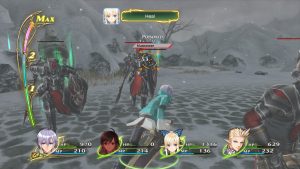
Back to combat basics, it’s hugely problematic how nearly impossible it is to read enemy attacks. Countless enemies will simply crouch down and turn red, charging for who knows what attack. A dragon may glow red then suddenly hit everyone within 5 meters or maybe it’ll just buff itself or maybe it’ll cast a spell in front of it…there’s no way of reading many enemies, so you can’t adapt and play smart.
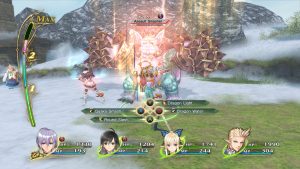
Moreover, there’s no way to directly take control of a character via an in-game menu or button press, which makes simple tasks so cumbersome. What’s worse, non-active party members don’t gain experience, so characters will fall way behind forcing you to grind XP.
Speaking of grinding, the game’s enemy level scaling is also terrible. You’re around level 3 after the introduction. Just minutes after that you’re asked to kill a griffon outside town. That griffon is level 11. Um, what? Where did levels 4 through 10 go? It seems the game wants you to spend 30 minutes mindlessly killing fodder enemies. Not sure how this makes the game more enjoyable…

The best part of the battle system is the ability to transform into the powerful Shining Dragon. It sounds awesome, but the terrible targeting, overly-long animations, and cumbersome movement make even cool dragon powers tedious as nearly every battle plays out the same messy button mashing way. Very sad.
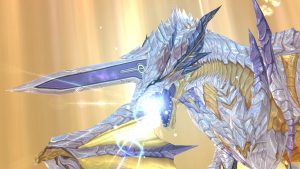
The saving grace of the combat system is the ability to freely switch to “Casual” difficulty and just brute force through the bad scaling and clunky combat, saving you hours of grinding. And even if you die, there’s always a “Continue” option that takes you to the Start menu, to heal up and try the combat encounter again. So that’s nice.
“How many pieces do you want to be sliced into?
You can pick any number you want to.” – Zest
To conclude on combat, Refrain’s battle system is sloppy and unacceptable compared to the many superior JRPGs available. The Tales of series flows so much better, as does the highly polished Ni no Kuni II. In-combat party management and tactics has been done so much better in countless JRPGs like Final Fantasy XII. Even the Final Fantasy XIII trilogy has a vastly superior “Break” system compared to Refrain’s…ahem…broken system.
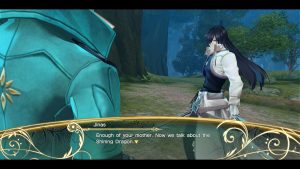
On the topic of this rerelease, the only truly new addition is the “Refrain” mode. Instead of taking time to properly implement two fan-favorite characters, this version lazily drops in these two party members at the start, despite this breaking the story experience.
If you care about the story, don’t play “Refrain” mode. If you care about getting all the Achievements, select “Refrain” or be forced to play the entire game again.
By the way, there’s no New Game Plus mode at all, which totally stinks because it would be a perfect fit to play the game again on the new “Refrain” mode while keeping all your dozens of hours of grinding progress. Fail.
“I’m looking for an answer to a question.
To find it… I need to kill dragons. That’s all.” – Jinus
So who in their right mind would endure the slog of combat in Refrain? Well, playing Refrain is like going to a beloved child’s three-hour beginner dance recital. Even though you know the actual performance wasn’t good by any objective standard, you still have a positive feeling with the event because of the heart connection.
Speaking of connections, one of the best parts of Refrain is the dating system. When in town or at camp you can try to invite each party member to a private night chat. These let you learn backstory and quirks, and eventually this leads to proper dates during the day. It’s all a lovely system that lets you choose to romance the girls and become best buddies with the guys. Very nice.
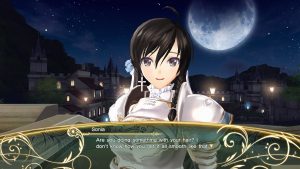
One quite enjoyable aspect linked to dating is the Trait system. You unlock well over 100 various Traits through different means, and then the Traits you equip combine with your party composition resulting in various occurrences during battle. It’s simple but fun.
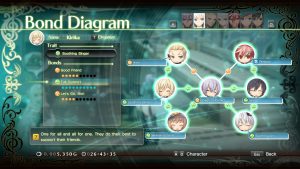
There’s also optional usually unvoiced non-serious story skits about shopping for groceries, cleaning, eating, and other daily-life scenarios meant to help the player feel connected to the characters and world. It mostly works even if some skits repeat.
There’s so much more to cover in regard to systems and terms like Armonics and B.A.N.D. and Tunings, but honestly none of this stuff matters very much. The characters, combat, and overall story are the cornerstones.
“I’m part of a team of friends, and we’re all
fighting back together.” – Yuma on His New Purpose
Given the game’s musical theme, it is strange to hear the poorly mixed audio. Dialogue can be muted at times. Music plays too quietly, and most of it is forgettable, sadly. In battle the sounds all clash over each other in a very displeasing way.
One very positive aspect is the voice acting. Nearly all main characters are well-voiced, with believable and excellent deliveries. Yuma, Agnum, and Excella are standouts. Some of the villains are too clichéd in their evil ways, but overall the voice work draws you in.

The story itself is set amidst political intrigue. One empire is trying to gain dominance, but various actors have their own personal motives and interests. It all flows nicely.
After 15 to 20 hours, at Chapter (called an Opus) 5, the story becomes much more engaging and deeper than expected…but many will have given up by then. Still, the payoff is there for those who stick around to see this grand symphony play out.
“You have the strength of arm and the
strength of heart to back up your words.” – Lestin
Ultimately, Resonance is a game about finding belonging through human connection and the power of interconnected hearts. The game manages to truly magnify friendship in a non-lame way, which is quite a feat. The player is taken on a wondrous journey through the power of teamwork, unified by song. A true resonance that shines brighter than the pain and despair (of the combat system).
So there we have it. Not an easy game to love, but sometimes choosing to care for the unlovely is the path to blessings. Or perhaps you should spend your hard-earned money on a game that respects your time and has quality gameplay and leave the charity cases to those with more forgiving hearts. Your choice!
![]()
- Surprisingly deep characters
- Strong character arcs
- Night chats and dating
- Mostly great voice acting
- Beautiful character designs
- Lengthy intriguing campaign
- “Casual” mode is welcome
- Must collect more Traits!
![]()
- Imprecise, clunky combat
- Moronic, maddening AI
- Bad enemy level scaling
- So much backtracking
- Uninspired level design
- Low-polygon, dated visuals
- No auto-saving at all
- No new game plus
Playtime: 65 hours total. Nick completed the campaign in about 42 hours. Another 23 hours was spent unlocking character endings and Achievements.
Computer Specs: Windows 10 64-bit computer using an Intel i7-3930k CPU, 32GB of memory, and a nVidia GTX 980 Ti graphics card.
Nick’s been a PC gamer for over 20 years, having grown up on first-person shooter games (he’s very proud of his Quake 2 tournament trophy). Nick also loves deep, engrossing role-playing games, and he’s also more famously known as Brumbek, the creator of Static Mesh Improvement Mod for Skyrim. Nick believes the essence of enjoyment is to play and ponder video games.
Contact: Email

